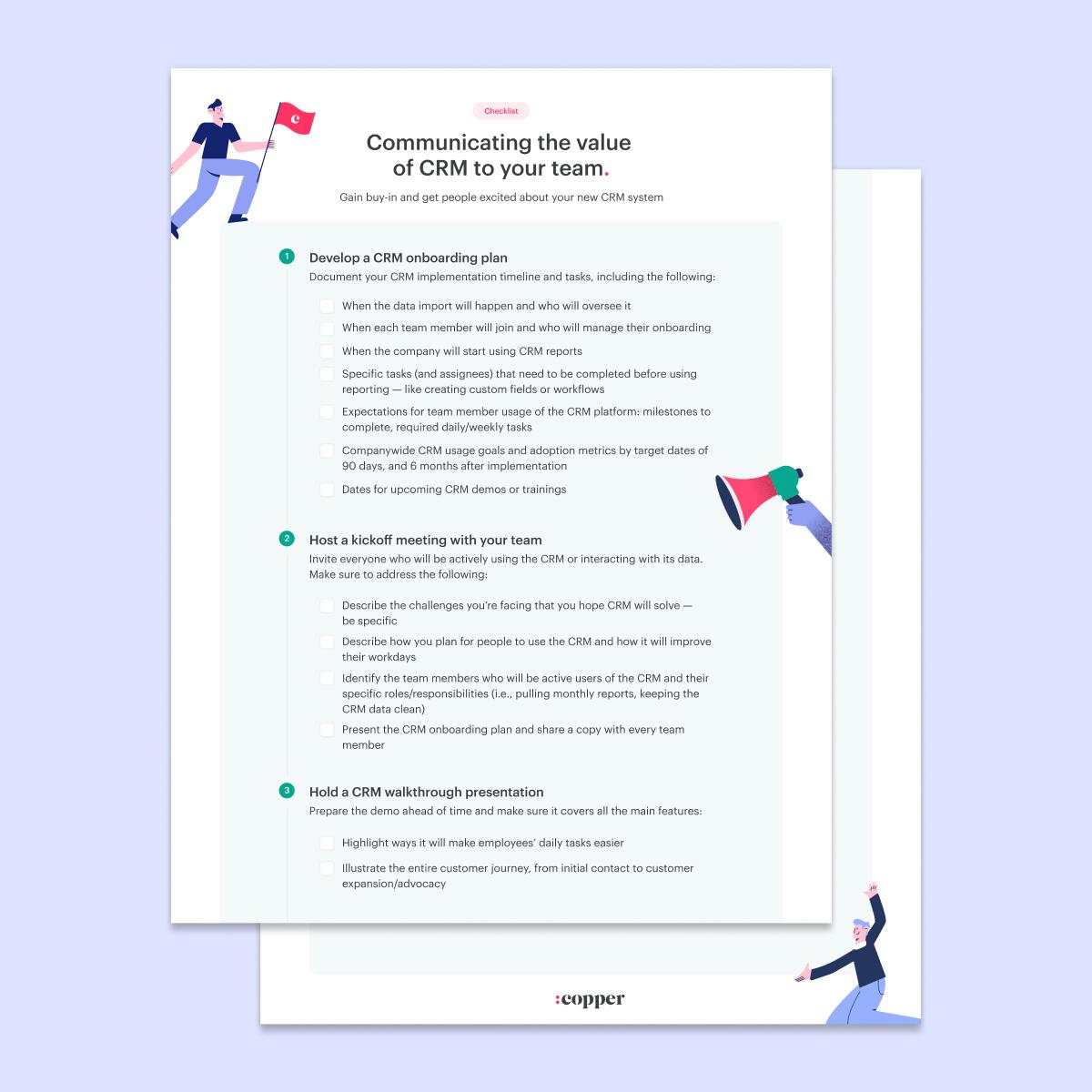Katrina Oko-Odoi
Sr. Content Marketing Manager
There’s no doubt that CRM helps streamline your sales processes, increase business efficiency, and keep track of prospect and customer data. But if your team doesn’t understand the value of CRM in the first place, they simply won’t use it.
From initial onboarding to introducing new features or custom fields, communicating the value of CRM to your team is a huge difference-maker. (Watch our previous Coffee with Copper webinar for a deep-dive into CRM adoption).
So how exactly do you communicate the importance of CRM? We’re breaking down what you need to do to get your team on board from the start.
4 steps for communicating the value of CRM from day one
Implementation of CRM software should be quick and easy, but effectively onboarding your team is a longer process — and takes a bit of planning and strategy to get people excited and invested. Follow these four steps to help motivate your team about CRM:
1. Communicate the value transparently
You understand why CRM is valuable for your business, but don’t skip sharing that insight with your team. Articulate how and why CRM benefits the company overall and your different teams specifically. People need to know exactly how the CRM platform will make their days easier and help improve their work processes or efficiency.
Start by hosting a kickoff meeting where you share what led to the decision to use CRM and why you chose your specific CRM system. It’s helpful to clearly outline the problems the business was facing without CRM (emphasizing challenges, like manual data entry, that employees may have struggled with) and communicate how the new platform will solve them. Also make sure to specify which team members will be using your CRM system so everyone knows what to anticipate.
2. Provide a thorough demo (including the special features)
Hearing about a CRM platform is one thing. Seeing it in action is another — which is why doing a walkthrough of the tool during the rollout makes all the difference.
Take time to clearly demonstrate the tailored journey your business will follow in the CRM software and highlight the special features that will make their lives easier. Walk them, step by step, through how you plan to use CRM in your organization, from initial contact through customer nurturing and expansion. Make sure to cover things like:
- How to track email communications
- Activity tracking
- Managing contact details
- Task logging
- Opportunities (and how to close them)
The goal here is to illustrate how valuable CRM will be in helping your employees accomplish their current tasks more easily. For example, if your sales reps currently have to manually type a note in a spreadsheet every time they send an email or SMS, demonstrate how the CRM system will now track each communication automatically — saving them tons of time.
Other processes to demonstrate include pipeline management and tracking deal progress. Show the team an opportunity and how to shift it through the stages, so they can really see it in action.
Prepare your demonstration ahead of time to ensure that it’s well organized and engaging, and clearly shows how the CRM system will make their lives easier.
For example, when our customers do walkthroughs of Copper with their internal staff, we always recommend showing the following valuable features:
- Email templates with merge fields for scalable communications
- Task automation for less repetitive admin work
- Integration capabilities with your tech stack
If the processes you’ll be demonstrating are dramatically different between departments, consider scheduling separate demos for each department to make sure the value doesn’t get lost in the weeds.
Get the latest from our blog every month
3. Show how they’ll access the CRM system
Part of your demo — in addition to any further CRM training and resources you develop — should show your team how they can access the CRM system and how they’re expected to incorporate it into their daily activities. Here’s where you might start:
- Show them how to log in and work from the CRM platform. Send out the link over email or Slack and make sure everyone bookmarks it for easy future access.
- If there’s a mobile app, make sure to give a demo of the app also — and have everyone download and install the app during your kickoff meeting. Discuss expectations for mobile app use for employees that are frequently on the road or on job sites.
- If your CRM system has a browser extension or plugin, also send the link to your team and ask them to install it. For example, Copper has a Chrome extension that lets users work straight from Gmail instead of switching tabs.
Take the opportunity to show your team how to access the CRM platform and easily fit it into their daily routine.
4. Share a clearly defined action plan
To make your long-term CRM strategy a reality, a concrete action plan is a must. At a minimum, this plan should share key dates and related tasks for the rollout, including:
- When the data import will happen and who will oversee it
- When each team member will join and who will manage their onboarding
- When the company will start using CRM reports and specific tasks that need to be completed before then (i.e., creation of custom fields or workflows)
A CRM onboarding plan should also cover how the team will hold each other accountable for using the platform after launch. For example, will there be 1:1 meetings? Will it be a part of the quarterly reviews? Are there specific milestones in CRM usage that employees are expected to achieve?
Also make sure to cover how (and when) you’ll measure CRM success. Finally, lay out some clear goals for CRM usage and adoption metrics.
Keep CRM team engagement going beyond the launch
It’s one thing to have an enthusiastic team in the beginning of CRM implementation. It’s a whole other thing to keep them fully engaged with the tool long-term. Increase your chances of companywide adoption by:
- Creating an internal playbook (or how-to guide)
- Asking for and incorporating team feedback (in quarterly meetings, via surveys, etc.)
- Providing ongoing training
A CRM platform isn’t a set-it-and-forget-it tool. It’s a part of your company’s tech stack that will evolve along with your organization. Do your best to keep your team involved and excited through every new feature and update along the way so you can fully reap the rewards of a well-implemented CRM system.
We created Copper CRM to make life easy for your team — from the ability to work straight in Gmail to task automation and automatic email, Contacts and Google Drive sync. Try us free for 14 days.

Checklist
Communicate CRM value to your team
Find out how to drive widespread team adoption in 6 simple steps.






